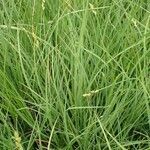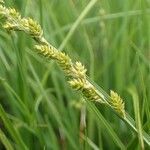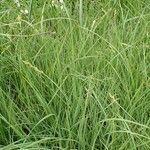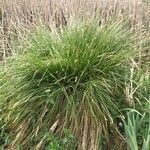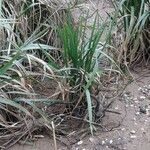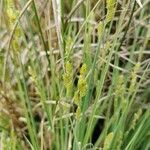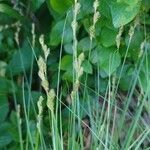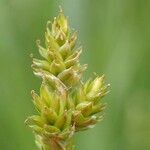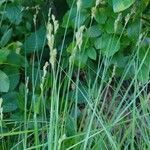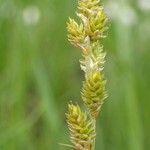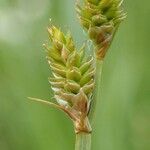Tufted, 2–6 dm; lvs mostly somewhat glaucous or grayish-green in life, clustered near the base, often shorter than the stems, ± flat, 1.5–3.5 mm wide; bracts inconspicuous, or the lowest ones setaceous-tipped and surpassing the spikes; spikes 4–8, gynaecandrous, 5–10 mm, sessile, the upper approximate, the lower usually somewhat remote, silvery-greenish to pale grayish or pale-stramineous; pistillate scales mostly shorter than the perigynia, these mostly (10–)15–30, ascending (the short beaks not interrupting the outline of the spike), mostly 1.8–2.5 mm, planoconvex, not thin-edged, minutely rough-textured, somewhat corky-thickened below, not especially thin-walled distally, elliptic or elliptic-ovate, with a beak-apiculation to 0.5 mm, evidently but rather finely nerved on both faces, the ventral nerves fewer than the dorsal; dorsal suture short and inconspicuous, to ca 0.4(–0.7) mm, or practically obsolete; achene lenticular, filling the perigynium; 2n=54, 56. Swamps and bogs; circumboreal, s. to Va., O., Minn., Ariz., and Calif.
Rhizome short. Culms tufted, 25-50 cm tall, erect, trigonous, scabrous above, clothed at base with brown bladeless sheaths. Leaves shorter than culm, blades 2-3 mm wide, flat, margins scabrous. Involucral bracts glumelike, proximal ones sometimes setaceous. Spikes 4-7, gynaecandrous, ovate-oblong, 6-10 × 3-4 mm; upper spikes congested, lower ones remote. Female glumes pale, ovate, ca. 2 mm, membranous, 1-veined, apex acute. Utricles green-brown, slightly longer than glume, ovate or elliptic, plano-convex, 2-2.2 × ca. 1.2 mm, membranous, glabrous, minutely tuberculate, brown-purple 5-12-veined on both faces, base subrounded, spongy, shortly stipitate, apex abruptly contracted into a slightly scabrous short beak, orifice emarginate. Nutlets tightly enveloped, elliptic or ovate, plano-convex, ca. 1.5 mm, base shortly stipitate; style base not thickened; stigmas 2. Fl. and fr. Jun-Aug. 2n = 56.
